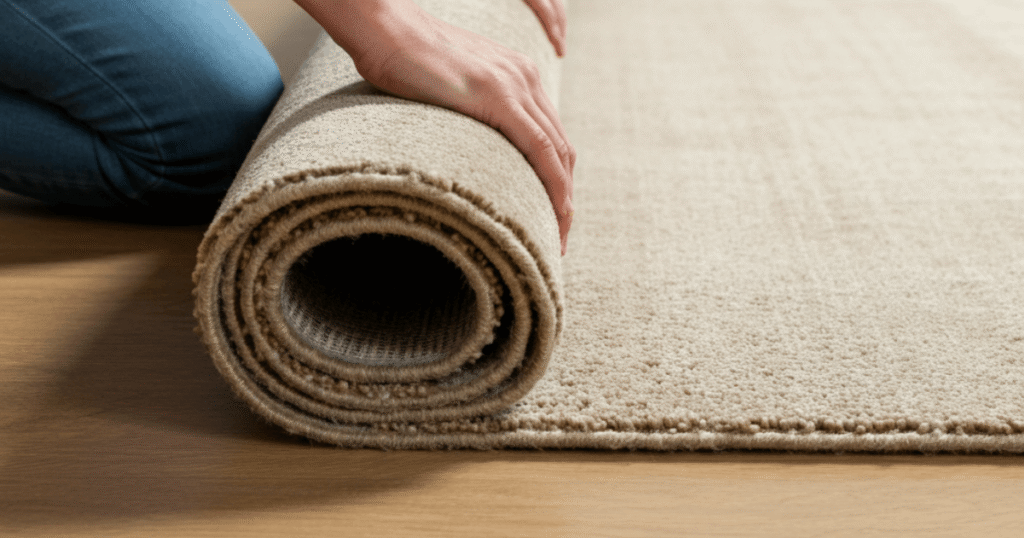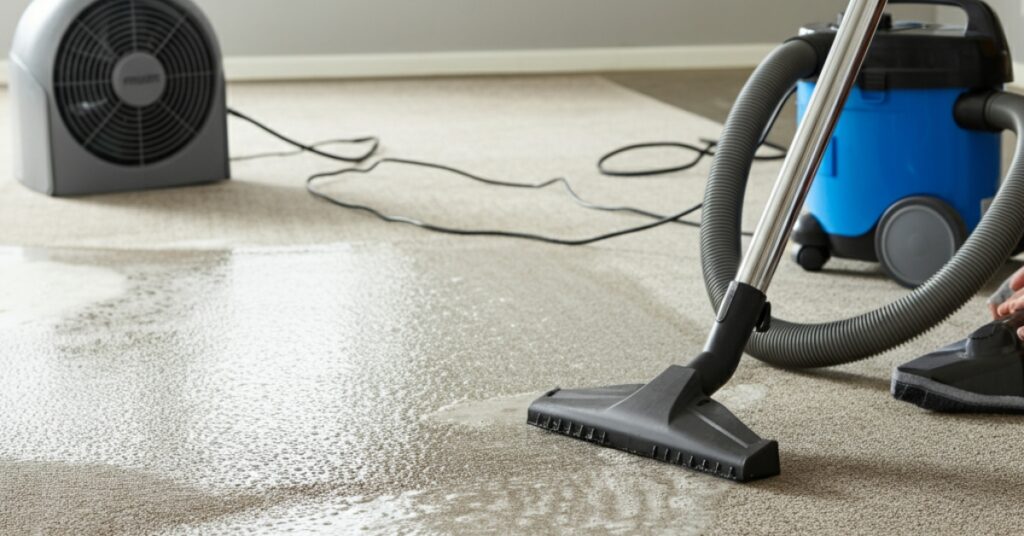As an Amazon Associate, I earn from qualifying purchases.
Knowing how long does it take to install carpet is crucial when you’re planning a home renovation project. This information helps you manage your schedule, prepare your space, and set realistic expectations for the installation day. The process involves several steps, and the total time can vary based on numerous factors specific to your project.
Generally, a professional installation team can carpet a single, standard-sized room of about 12×12 feet in approximately 3 to 4 hours. However, for an entire house, the project could span one to three days. This timeline depends on the complexity of the job, the preparation required, and the size of the area being carpeted. Understanding these variables will give you a much clearer picture of your project’s duration.
Factors Influencing How Long It Takes to Install Carpet

Several key elements can either speed up or slow down the carpet installation process. When you get a time estimate from installers, they are considering these specific details of your project. Being aware of them yourself can help you understand and even streamline the timeline.
One of the most significant factors is the preparation of the subfloor. A clean, level, and dry subfloor is essential for a quality installation. If the existing subfloor needs repairs, such as fixing cracks or leveling uneven spots, this will add considerable time. Similarly, the process of moving furniture and removing the old flooring are major time considerations.
Preparation of the Room
Before any new carpet can go down, the room must be completely ready. This preparation phase is often the most time-consuming part of the installation. A well-prepared space allows installers to work efficiently and without interruption, leading to a faster, smoother process.
First, you must move all furniture out of the room. This includes large items like beds and dressers, as well as smaller decorative pieces. If you hire the installers to do this, it will add to the overall time and cost. Next, the old flooring needs to be removed. Whether it’s old carpet, hardwood, or tile, this process can be labor-intensive, especially if the flooring is glued down.
Size and Layout of the Area
The size of the area you are carpeting is a primary driver of the installation timeline. A larger space naturally requires more materials and more time to cover. For instance, carpeting a 500-square-foot living room will take significantly longer than a 150-square-foot bedroom.
Additionally, the layout of the room plays a crucial role. A simple, square, or rectangular room is straightforward to carpet. In contrast, rooms with irregular shapes, multiple closets, alcoves, or architectural features like built-in shelving require more intricate cutting and fitting. These complexities demand precision from the installers and, as a result, extend the time needed to complete the job.
Carpet Type and Installation Method
The type of carpet you choose also affects the installation time. Some materials are more challenging to work with than others. For example, thick, plush carpets can be heavier and more difficult to cut and stretch compared to standard loop-pile carpets.
Furthermore, the installation method makes a difference. The most common method is stretch-in installation, where the carpet is attached to tack strips along the room’s perimeter. This is generally a quick process for skilled professionals. However, a glue-down installation, often used in commercial settings or on concrete subfloors, can be more time-consuming because it requires careful application of adhesive and a curing period.
Presence of Stairs and Complex Areas
Stairs are one of the most complex and time-intensive areas to carpet. Each step and riser must be measured, cut, and fitted individually. This meticulous work requires a high level of skill and precision to ensure the carpet is secure and the pattern, if any, aligns correctly.
Therefore, a project involving a staircase will take considerably longer than one that only covers flat rooms. Installers often estimate that carpeting a standard flight of 12-14 stairs can take an additional 2 to 4 hours. If your project includes multiple staircases or stairs with intricate spindles, you should account for even more time.
Breakdown of the Installation Timeline
To better understand how long it takes to install carpet, it is helpful to break down the process into its individual stages. Each phase has its own time requirements, and together they form the complete installation timeline from start to finish.
The process begins long before the new carpet is unrolled. It starts with preparing the space, which includes removing old flooring and ensuring the subfloor is in perfect condition. After that, the actual installation can begin, followed by the final cleanup.
Moving Furniture and Old Flooring Removal
The first physical step on installation day is clearing the room. If you have not done so already, the installation crew will begin by moving all furniture out of the area. The time this takes depends entirely on the amount and weight of the furniture. A room with just a few light pieces might take 15-30 minutes, while a room full of heavy furniture could take an hour or more.
After clearing the room, the crew will remove the existing flooring. Ripping up old carpet is relatively fast, typically taking about 15-20 minutes for an average-sized room. However, removing other types of flooring, like tile or glued-down wood, can be much more labor-intensive and add several hours to the project. Proper disposal of the old materials also takes time.
Subfloor Preparation and Repair
Once the old flooring is gone, the subfloor is exposed and must be thoroughly inspected. A professional installer will check for any damage, such as cracks, water damage, or unevenness. A clean, smooth, and level subfloor is non-negotiable for a lasting carpet installation.
If the subfloor is in good shape, a quick cleaning might be all that’s needed, taking about 30 minutes. However, if repairs are necessary, the timeline can extend significantly. Patching cracks or leveling compounds needs time to set and dry, which could add anywhere from a few hours to an entire day to the schedule before the carpet can be installed.
Laying the Padding and Carpet
With a prepared subfloor, the installers can begin laying the foundation for your new carpet. First, they install the carpet padding. This involves rolling it out, cutting it to size, and securing it to the subfloor, usually with staples. For a standard room, this step typically takes about 30 to 45 minutes.
Next comes the main event: laying the carpet. The installers will bring in the large, heavy roll of carpet, position it, and begin making the primary cuts. They then use a power stretcher to stretch the carpet tightly across the room and attach it to the tack strips along the walls. This process requires precision and strength and usually takes 1 to 2 hours for a simple, average-sized room.
Seaming, Trimming, and Finishing Touches
If the room is wider than the carpet roll (which is usually 12 or 15 feet), a seam will be necessary. Creating an inconspicuous seam is an art that involves carefully aligning the carpet edges and bonding them together with special seam tape and a seam iron. This process can add an extra 30 minutes per seam to the installation time.
Finally, the installers will trim the excess carpet around the perimeter of the room and tuck the edges neatly for a clean finish. They will also install transition strips where the carpet meets other types of flooring. The final step is a thorough vacuuming of the new carpet to pick up any loose fibers. This cleanup and finishing phase typically takes another 30 minutes.
Your Guide to a Smoother Carpet Installation
You can take several proactive steps to ensure your carpet installation goes as smoothly and quickly as possible. Proper preparation on your part can significantly reduce the time installers need to spend on-site, saving you both time and potential labor costs.
By handling some of the preliminary tasks yourself and communicating clearly with your installation team, you can help prevent delays and ensure the project stays on schedule. These efforts will contribute to a more efficient process and a better final result.
Communicate Clearly With Your Installers
Effective communication is essential from the very beginning. When you get a quote, be detailed about the scope of the project. Mention any complexities like stairs, irregular room shapes, or the type of existing flooring that needs to be removed. This allows the installers to provide a more accurate time estimate.
Before installation day, confirm who is responsible for moving furniture. If you plan to do it yourself, make sure the room is completely empty before the crew arrives. Also, discuss any specific concerns you have, such as the placement of seams or how they will handle transitions to other flooring types. Clear communication prevents misunderstandings and helps the team work more efficiently.
Prepare the Installation Area Yourself
Taking on some of the prep work is one of the best ways to speed up the installation process. If you are able, move all furniture, decorations, and personal items out of the room. This includes emptying closets if they are also being carpeted. Having a clear, open space allows the installers to get straight to work.
Additionally, if you feel comfortable doing so, you can remove the old carpet and padding yourself. This can save the installation crew a significant amount of time. Just be sure you know how to do it correctly to avoid damaging the subfloor. Check with your local waste management service for instructions on how to dispose of the old materials properly.
Plan for a Full Day, Just in Case
Even with the best planning, unexpected issues can arise. The subfloor might reveal hidden damage, or a particularly tricky cut might take longer than anticipated. Because of these potential variables, it’s wise to block out the entire day for the installation, even if the estimate is only a few hours.
This approach reduces stress and ensures you won’t be rushing the installers to finish. Giving the team ample time to do their work without pressure allows them to focus on quality and detail, resulting in a better, longer-lasting installation. Don’t schedule other appointments or deliveries for the same day, and arrange for pets and small children to be in a separate, secure area away from the work zone.
Final Thoughts

Understanding how long it takes to install carpet helps you plan your project effectively and minimize disruption to your home life. While a single room can often be completed in half a day, factors like room size, complexity, subfloor condition, and the presence of stairs can extend the timeline. By preparing the space and communicating clearly with your professional installers, you can ensure a smooth and efficient process. Ultimately, allowing the professionals the time they need to do the job right will result in a beautiful, durable carpet that you can enjoy for years to come.
Frequently Asked Questions
1. Can carpet be installed in one day?
Yes, in most cases, a carpet installation for a few rooms or an area up to about 1,000 square feet can be completed in a single day. A single, average-sized room typically takes only a few hours.
2. Does furniture need to be moved before carpet installation?
Yes, all furniture and personal items must be removed from the area before the installers can begin. You can either do this yourself to save time or arrange for the installation company to handle it for an additional fee.
3. How long after carpet installation can you walk on it?
You can typically walk on your new carpet immediately after installation. However, it is a good idea to limit heavy foot traffic and avoid dragging furniture across it for at least 24 hours to allow everything to settle.
4. How long does it take to carpet a 12×12 room?
For a standard, square 12×12 foot room with no major complexities, a professional installer can typically complete the job in about 3 to 4 hours. This includes removing old carpet and installing new padding and carpet.
5. How long does it take to install carpet on stairs?
Carpeting a standard flight of 12-14 stairs usually takes an additional 2 to 4 hours on top of the time for any other rooms. Stairs require meticulous, time-consuming work to ensure a safe and polished finish.
As an Amazon Associate, I earn from qualifying purchases.




